Module9 A trip to the zoo Unit1 Does the tiger eat meat —孙元起
- 格式:ppt
- 大小:9.59 MB
- 文档页数:22
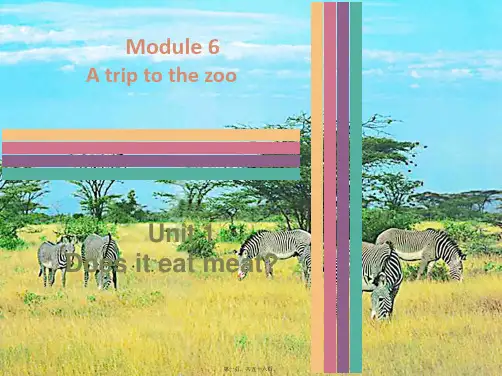
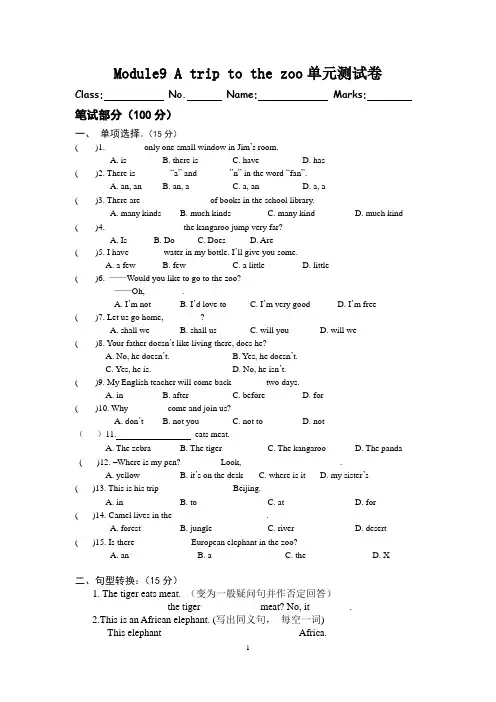
Module9 A trip to the zoo单元测试卷Class: No. Name: Marks: 笔试部分(100分)一、单项选择。
(15分)( )1. ________ only one small window in Jim’s room.A. isB. there isC. haveD. has( )2. There is _______ ―a‖ and _______‖n‖ in the word ―fan‖.A. an, anB. an, aC. a, anD. a, a( )3. There are _______________ of books in the school library.A. many kindsB. much kindsC. many kindD. much kind ( )4. _________________ the kangaroo jump very far?A. IsB. DoC. DoesD. Are( )5. I have _______ water in my bottle. I’ll give you some.A. a fewB. fewC. a littleD. little( )6. ——Would you like to go to the zoo?——Oh, ________.A. I’m notB. I’d love toC. I’m very goodD. I’m free( )7. Let us go home, ________?A. shall weB. shall usC. will youD. will we( )8. Your father doesn’t like living there, does he?A. No, he doesn’t.B. Yes, he doesn’t.C. Yes, he is.D. No, he isn’t.( )9. My English teacher will come back _______ two days.A. inB. afterC. beforeD. for( )10. Why ________ come and join us?A. don’tB. not youC. not toD. not()11. eats meat.A. The zebraB. The tigerC. The kangarooD. The panda ( )12. –Where is my pen? --Look, ______________________.A. yellowB. it’s on the deskC. where is itD. my sister’s( )13. This is his trip ________________ Beijing.A. inB. toC. atD. for( )14. Camel lives in the _____________________.A. forestB. jungleC. riverD. desert ( )15. Is there ____________ European elephant in the zoo?A. anB. aC. theD. X二、句型转换:(15分)1. The tiger eats meat. (变为一般疑问句并作否定回答)___________ the tiger ___________ meat? No, it ______.2.This is an African elephant. (写出同义句,每空一词)This elephant _____________ __________ Africa.3.Polar bears eat meat. Pandas eat bamboo. (连接句子)Polar bears eat meat__________ Pandas eat bamboo.4.There is some milk in his fridge. (写出同义句,每空一词)He ________ __________ some milk in the fridge.5.Lingling is in the classroom. (就画线部分提问)_____________ ___________ Lingling ?6..She does morning exercises every day. (改为一般疑问句)__________she ___________ morning exercises every day?7. This kind of animal eats grass and leaves. (否定句)This kind of animal grass leaves.三、根据首字母、中文或句意提示,写出单词。
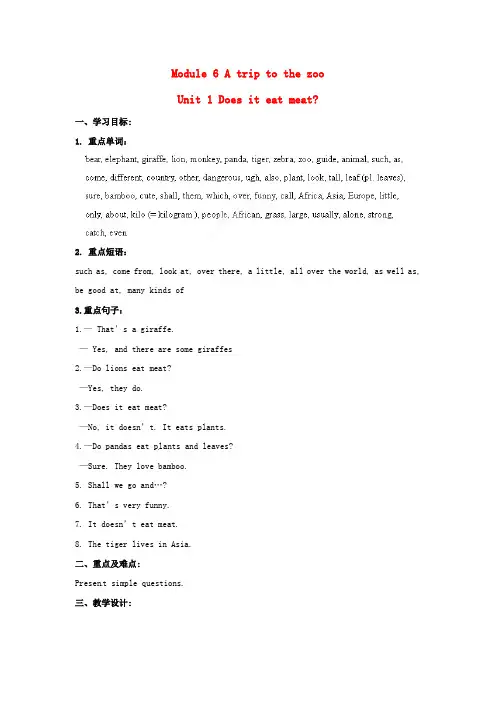
Module 6 A trip to the zooUnit 1 Does it eat meat?一、学习目标:1. 重点单词:2. 重点短语:such as, come from, look at, over there, a little, all over the world, as well as, be good at, many kinds of3.重点句子:1.— That’s a giraffe.— Yes, and there are some giraffes2.—Do lions eat meat?—Yes, they do.3.—Does it eat meat?—No, it doesn’t. It eats plants.4.—Do pandas eat plants and leaves?—Sure. They love bamboo.5. Shall we go and…?6. That’s very funny.7. It doesn’t eat meat.8. The tiger lives in Asia.二、重点及难点:Presen t simple questions.三、教学设计:Unit 1 Does it eat meat?ⅠTeaching modelListening and speakingⅡTeaching meth odInteractive approachⅢTeaching aims1. To find specific information in the listening.2. To recognize t he third person singular endings –s.3. To ask and answer questions about animals.4. To enable students to talk about animals.ⅣTeaching ObjectivesKey vocabulary: bear, elephant, giraffe, lion, monk ey, panda, tiger, zebra, zoo, guide, animal, such, as, come, different, country, other, dangerous,ugh, also, plant, look, tall, le af (pl. leaves), sure, bamboo, cute,shall, them, which, over, funny, callKey structures:1.— That’s a giraffe. — Yes, and there are some giraffes2.—Do lions eat meat? —Yes, they do.3.—Does it eat meat? —No, it doesn’t. It eats plants.4.—Do pandas eat plants and leaves? —Sure. They love b amboo.5. Shall we go and…?6. That’s very funny.ⅤTeaching aidsTape recorder , OHP , video , a clockⅥTeachi ng StepsStep 1 Warming-up1. Lead inT: Hello, boys and girls!Ss: Hello, Mr. Zhang.T: Today, we are going to learn Module 6 A trip to the zoo. Have you been to thezoo?Ss: Yes.T: D o you know Beijing zoo?S1: Yes, I went there last year. I saw many animals…S2:…T: OK. Today I’ll take you to visit Beijing zoo. Are you happy?Ss: Yes.T: Please look at the screen and get to know some information about Beijing Zoo. Ss: …(Look at the scre en and try to know some information about it.)2. Show some pictures to ask and answer: What can you see?3. Call back the answer from the whole class and check the answer.Step 2 Practice1. Show some pictures of the animals.2. Introduce the new words.3. Look at the pictures. Ask and answer: What can you see?4. Call back the answers from the whole class and check the answer .5. Read the words.Step 3 Work in pairs1. Listen and check ( √) the words in Activity 1 you hear.2. Now work in pairs and say what you can see.—That’s a giraffe.—Yes, and there are some giraffesStep 4 Listen and read.1. Ask the students to read the conversation silently.2. Play the recording and ask the students to listen and read the conversation.3. Read the conversation.4. Act it out.5. Ask the students to complete the table in Activity 3.6. Call back the answer from the whole class and check the answer.Keys: 1. meat, other animals 2. meat, plants 3. plants 4. bambooStep 5 Underline the correct words.1. Ask the students to read through the passage.2. Underline the correct words.3. Call back the answer from the whole class and check the answer.Keys: 1. many 2. countries 3. such 4. dangerous 5. plants 6. different7. tall 8. plants 9. bamboo 10. panda’sStep 6 Listen and repeat.1. Play the recording once without stopping.2. Play the recording again and stop at the end of each line. Ask the whole class to repeat.3. Play the recording again and stop at the end of each line. Ask individual students to repeat.4. Ask the students to practice the sounds in pairs.Step 7 Listen and choose / s/ or / z /1. Play the recording once without stopping.2. Play the recording again and stop at the end of each line. Ask the whole class to repeat.3. Play the recording again and stop at the end of each line. Ask individual students to repeat.4. Ask the students to practice the sounds in pairs.Step 8 Work in pairs .Talk about your lessons .1. Go through the language in the substitution table with the class.2. Pair them to ask and answer.A: What’s your favourite animal? Does it eat plants?B: Yes, it does.A: Does it come from China?B: Yes, it does.A: Is it the panda?3. Circulate and monitor their production.Step 9 Do exercises:A.首字母填空:1. Beijing Zoo has many kinds of a______.2. The lions are d__________ because they eat meat.3. Pandas are black and white and eat b__________.4. The b_______ eat meat and plants.5. An e__________ is tall and ea ts plants.Answers:1. animals2.dangerous3.bamboo4.bears5. elephantB.翻译下列句子:1.这些动物来自不同的国家。
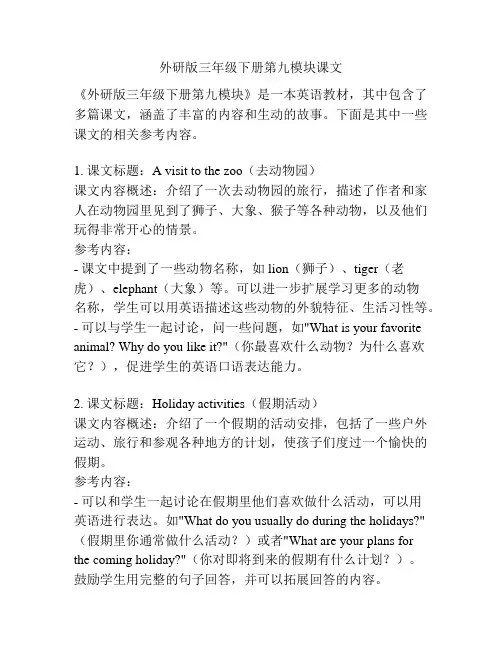
外研版三年级下册第九模块课文《外研版三年级下册第九模块》是一本英语教材,其中包含了多篇课文,涵盖了丰富的内容和生动的故事。
下面是其中一些课文的相关参考内容。
1. 课文标题:A visit to the zoo(去动物园)课文内容概述:介绍了一次去动物园的旅行,描述了作者和家人在动物园里见到了狮子、大象、猴子等各种动物,以及他们玩得非常开心的情景。
参考内容:- 课文中提到了一些动物名称,如lion(狮子)、tiger(老虎)、elephant(大象)等。
可以进一步扩展学习更多的动物名称,学生可以用英语描述这些动物的外貌特征、生活习性等。
- 可以与学生一起讨论,问一些问题,如"What is your favorite animal? Why do you like it?"(你最喜欢什么动物?为什么喜欢它?),促进学生的英语口语表达能力。
2. 课文标题:Holiday activities(假期活动)课文内容概述:介绍了一个假期的活动安排,包括了一些户外运动、旅行和参观各种地方的计划,使孩子们度过一个愉快的假期。
参考内容:- 可以和学生一起讨论在假期里他们喜欢做什么活动,可以用英语进行表达。
如"What do you usually do during the holidays?"(假期里你通常做什么活动?)或者"What are your plans forthe coming holiday?"(你对即将到来的假期有什么计划?)。
鼓励学生用完整的句子回答,并可以拓展回答的内容。
- 可以向学生介绍一些假期旅行的英文表达,如go hiking(去徒步旅行)、visit museums(参观博物馆)、have a picnic (野餐)等,帮助学生扩展他们的词汇量。
3. 课文标题:The lost kitten(迷失的小猫)课文内容概述:讲述了一个小男孩Tom在街上发现了一只迷失的小猫,他带着小猫回家,和家人一同寻找小猫的主人,最后让小猫和主人团聚的故事。
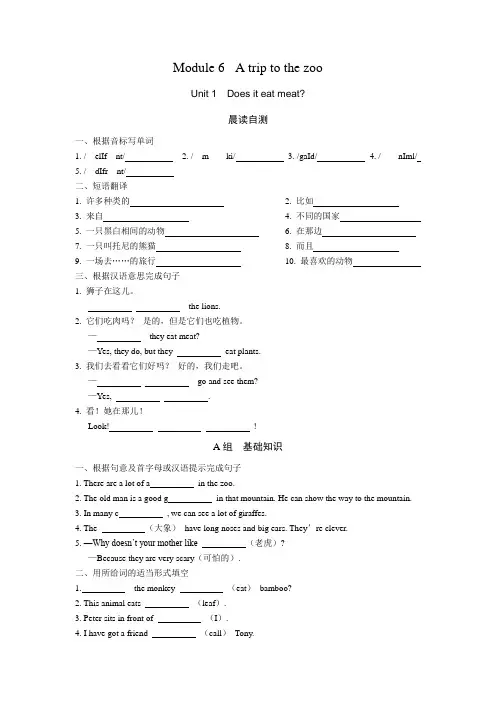
Module 6 A trip to the zooUnit 1 Does it eat meat?晨读自测一、根据音标写单词1. /elIf nt/2. /m ki/3. /gaId/4. /nIml/5. /dIfr nt/二、短语翻译1. 许多种类的2. 比如3. 来自4. 不同的国家5. 一只黑白相间的动物6. 在那边7. 一只叫托尼的熊猫8. 而且9. 一场去……的旅行10. 最喜欢的动物三、根据汉语意思完成句子1. 狮子在这儿。
the lions.2. 它们吃肉吗?是的,但是它们也吃植物。
—they eat meat?—Yes, they do, but they eat plants.3. 我们去看看它们好吗?好的,我们走吧。
—go and see them?—Yes, .4. 看!她在那儿!Look! !A组基础知识一、根据句意及首字母或汉语提示完成句子1. There are a lot of a in the zoo.2. The old man is a good g in that mountain. He can show the way to the mountain.3. In many c , we can see a lot of giraffes.4. The (大象)have long noses and big ears. They’re clever.5. —Why doesn’t your mother like (老虎)?—Because they are very scary(可怕的).二、用所给词的适当形式填空1. the monkey (eat)bamboo?2. This animal eats (leaf).3. Peter sits in front of (I).4. I have got a friend (call)Tony.5. What about (go)to the park?6. Here (be)two old houses.7. We usually (do)our homework on Sunday.8. There are five (monkey)in that small zoo.三、用方框中所给词的适当形式填空there dangerous different such panda1. We can see many kinds of animals on the farm.2. It’s very for you to play with lions.3. I like because they are very cute and they only live in China.4. Do you like the giraffe over ?5. There are many kinds of animals in the zoo, as tigers, monkeys and zebras.B组能力提升一、根据右边句子的描述和首字母提示,写出动物名称1. e It is very strong(强壮)and tall, it has a long nose.2. m It loves to eat bananas. It’s clever(聪明)and good at climbing(攀爬).3. g It is very tall and has a very long neck(头颈).4. t It’s very dangerous. It likes to eat meat and other animals.5. k It comes from Australia. It’s good at jumping(跳).二、句型转换1. The boy in front of me is my friend. (对画线部分提问)is friend?2. The elephant eats meat. (改为否定句)The elephant meat.3. He does homework every day. (改为一般疑问句,并作否定回答)—he homework every day?—, he .4. I have got a cousin. His name is John. (合并为一句)I have got a cousin .5. Lucy is from America. (改为同义句)Lucy America./Lucy is .6. The elephant likes plants. (改为否定句)The elephant plants.7. The panda eats bamboo. (改为一般疑问句,并作肯定回答)—the panda bamboo?—Yes, .8. The kangaroo comes from Australia. (对画线部分提问)Where the kangaroo ?9. The zoo has five thousand animals. (改为同义句)five thousand animals in the zoo.10. I live in China and I speak Chinese. (用she改写句子)She in China and she Chinese.三、完形填空Today is Sunday. Jim and his classmates 1 no classes. They go to the zoo. Amy 2 to see birds flying in the sky. Lucy has a 3 in her hand, and she wants to give it 4 a monkey. Jane likes pandas. They 5 from Sichuan. Tom 6 tigers are lovely, 7 Lily doesn’t think so. She thinks 8 are dangerous. She asks Tom 9 the dolphins(海豚). She thinks dolphins are 10 , and they can dance very well. Jim and his classmates are very happy today.()1. A. has B. is C. have D. are()2. A. likes B. look C. says D. like()3. A. book B. knife C. pears D. banana()4. A. at B. for C. to D. on()5. A. want B. come C. go D. comes()6. A. thinks B. loves C. speaks D. likes()7. A. and B. or C. but D. too()8. A. it B. she C. they D. he()9. A. to see B. go out C. make D. to make()10. A. bad B. clever C. dirty D. dangerous四、阅读理解AnimalCountry Australia China South AfricaDescription(描述)It is cute and small. Iteats leaves. It likessleeping inthe trees. It’s fat and cute. It’sblack andwhite. Iteats bamboo.It’s veryquiet andstrong. Iteats grassand leaves.Its nose isvery long.Time Only weekends 8:00 am—4:00 pmTickets Adults: $10.00Children: Over 10: $5.00Under 10: free()1. Where is the elephant from?A. China.B. Australia.C. South Africa.D. America. ()2. is cute and eats bamboo.A. The koalaB. The pandaC. The elephantD. The dolphin()3. You can visit the zoo at .A. 9:30 am on SaturdayB. 5:30 pm on SundayC. 8:50 pm on TuesdayD. 2:30 pm on Thursday()4. Tom is 13 years old. He goes to the zoo with his mother. They spend(花费).A. $10B. $20C. $5D. $15()5. Which of the following is TRUE?A. The koala has a long nose.B. The panda is black and fat.C. The koala is often in the tree.D. The zoo is open every day.五、任务型阅读There is a zoo in my city. It has four new animals today, a panda, a lion, a koala and a giraffe. The panda’s name is Molly. It is from China and it’s three years old. It likes eating bamboo. It is very cute but kind of shy. The name of the lion is Bill and it comes from Africa. It is five years old and it likes meat best. It is a strong and dangerous animal. So don’t be near it. The third one is Lorry. It is a koala of two years old. It is from Australia. It is very lazy but smart. It sleeps during the day and at night it gets up to eat leaves. The last one is a giraffe. It is very beautiful. Its name is Polly. Polly is four years old and is from South Africa. It has a long neck. It likes eating grass very much.根据短文内容,完成表格。
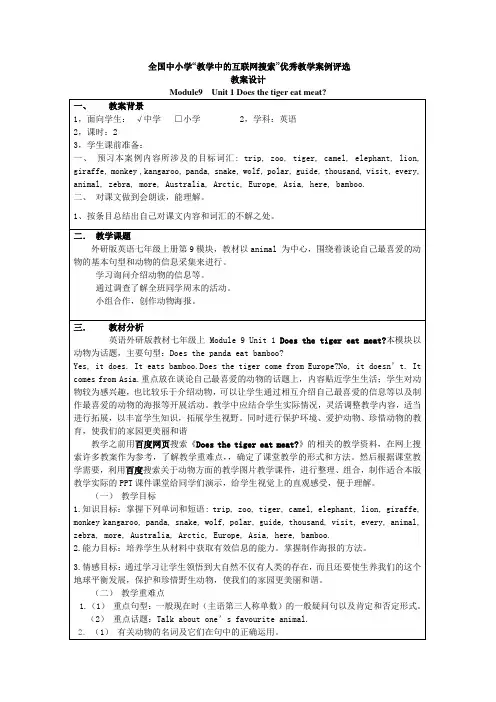
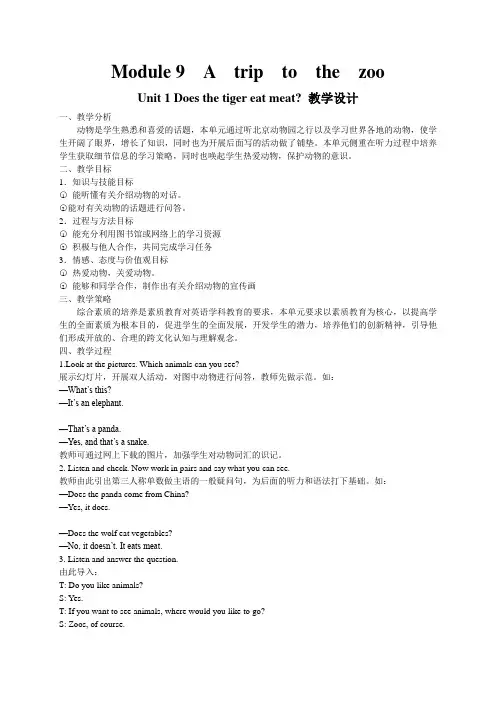
Module 9 A trip to the zooUnit 1 Does the tiger eat meat? 教学设计一、教学分析动物是学生熟悉和喜爱的话题,本单元通过听北京动物园之行以及学习世界各地的动物,使学生开阔了眼界,增长了知识,同时也为开展后面写的活动做了铺垫。
本单元侧重在听力过程中培养学生获取细节信息的学习策略,同时也唤起学生热爱动物,保护动物的意识。
二、教学目标1.知识与技能目标○1能听懂有关介绍动物的对话。
○2能对有关动物的话题进行问答。
2.过程与方法目标○1能充分利用图书馆或网络上的学习资源○2积极与他人合作,共同完成学习任务3.情感、态度与价值观目标○1热爱动物,关爱动物。
○2能够和同学合作,制作出有关介绍动物的宣传画三、教学策略综合素质的培养是素质教育对英语学科教育的要求,本单元要求以素质教育为核心,以提高学生的全面素质为根本目的,促进学生的全面发展,开发学生的潜力,培养他们的创新精神,引导他们形成开放的、合理的跨文化认知与理解观念。
四、教学过程1.Look at the pictures. Which animals can you see?展示幻灯片,开展双人活动,对图中动物进行问答,教师先做示范。
如:—What’s this?—It’s an elephant.—That’s a panda.—Yes, and that’s a snake.教师可通过网上下载的图片,加强学生对动物词汇的识记。
2. Listen and check. Now work in pairs and say what you can see.教师由此引出第三人称单数做主语的一般疑问句,为后面的听力和语法打下基础。
如:—Does the panda come from China?—Yes, it does.—Does the wolf eat vegetables?—No, it doesn’t. It eats meat.3. Listen and answer the question.由此导入:T: Do you like animals?S: Yes.T: If you want to see animals, where would you like to go?S: Zoos, of course.T: Which zoo have you been to?S: …T: Anybody who has been to Beijing Zoo?S: No.T: Ok. Today I’d like to take you to Beijing Zoo. Here is the guide of the zoo. A guide is a person whose job is to show interesting places to visitors. Daming and Lingling are talking to the guide. Listen to their conversation and answer this question: what is the name of the panda? (Answers: It’s Lingling.)4. Listen and check.听对话,判断正误开展双人活动,核对答案。
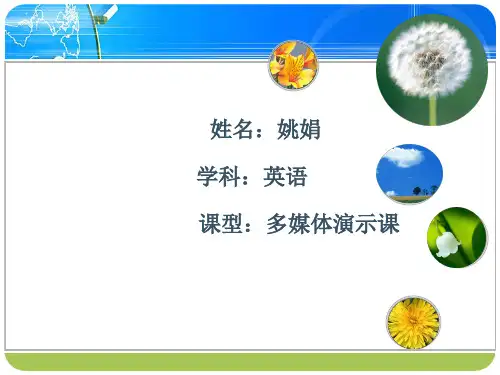
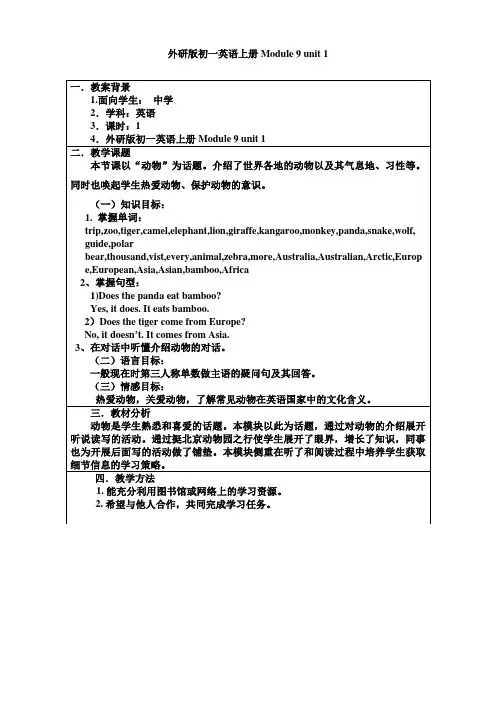
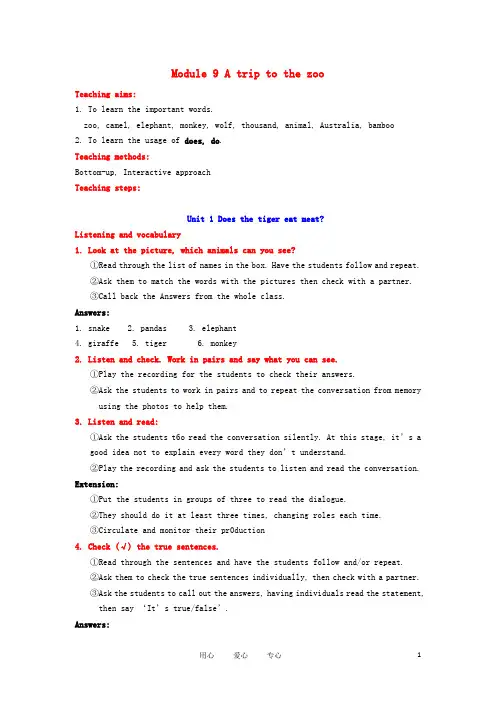
Module 9 A trip to the zooTeaching aims:1. To learn the important words.zoo, camel, elephant, monkey, wolf, thousand, animal, Australia, bamboo2. To learn the usage of does, do.Teaching methods:Bottom-up, Interactive approachTeaching steps:Unit 1 Does the tiger eat meat?Listening and vocabulary1. Look at the picture, which animals can you see?①Read through the list of names in the box. Have the students follow and repeat.②Ask them to match the words with the pictures then check with a partner.③Call back the Answers from the whole class.Answers:1. snake2. pandas3. elephant4. giraffe5. tiger6. monkey2. Listen and check. Work in pairs and say what you can see.①Play the recording for the students to check their answers.②Ask the students to work in pairs and to repeat the conversation from memoryusing the photos to help them.3. Listen and read:①Ask the students t6o read the conversation silently. At this stage, it’s agood idea not to explain every word they don’t understand.②Play the recording and ask the students to listen and read the conversation. Extension:①Put the students in groups of three to read the dialogue.②They should do it at least three times, changing roles each time.③Circulate and monitor their pr0duction4. Check (√) the true sentences.①Read through the sentences and have the students follow and/or repeat.②Ask them to check the true sentences individually, then check with a partner.③Ask the students to call out the answers, having individuals read the statement,then say ‘It’s true/false’.Answers:1. ×2. ×3. √4. ×5. √6. √7. √8. ×Extension:①Ask the students to correct the false statements.(e.g. the polar bear comesfrom China. No, it doesn’t. It comes from the Arctic.)②They should do this individually, then check with a partner.③Cal back the answers from the whole class.Pronunciation and speaking:5. Listen and repeat:①Explain that this activity focuses on some English phonemes which are difficultto pronounce for speakers of Chinese.②Play the recording once without stopping.③Play the recording again and stop at the end of each line. Ask the whole classto repeat.④Play the recording again and stop at the end of each line. Ask individualstudents to repeat.⑤Ask the studnets to practice the sounds in pairs.6. Listen and repeat the questions and answers:①Ask the students to read through the sentences.②Play the recording through while they listen and follow.③Play it again, pausing for them to repeat chorally and individualy.④Pay particular attention to the question form intonation7. Work in pairs. Ask and answer the questions:①Ask the student to find the answers to all the questions individually.②Pair them to ask and answer the questions.③Call back some questions and answers from the pairs in a whole class setting. Do exercises:Ⅰ.根据句意及首字母提示补全单词。
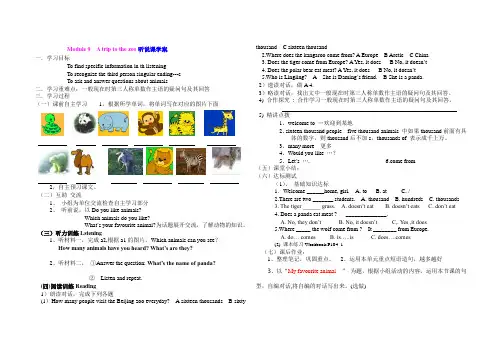
Module 9 A trip to the zoo 听说课学案一.学习目标To find specific information in th listeningTo recognize the third person singular ending---sTo ask and answer questions about animals二.学习重难点:一般现在时第三人称单数作主语的疑问句及其回答三.学习过程(一)课前自主学习 1,根据所学单词,将单词写在对应的图片下面2,自主预习课文。
(二)互助 交流1、 小组为单位交流检查自主学习部分2、 听前说,以Do you like animals?Which animals do you like?What ’s your favourite animal?为话题展开交流,了解动物的知识。
(三)听力训练Lstening1、听材料一,完成a2,根据a1的图片,Which animals can you see ?How many animals have you heard? What’s are they?2、听材料二, ①Answer the question: What’s the name of panda?② Listen and repeat.(四)阅读训练Reading1)朗读对话,完成下列各题(1)How many people visit the Beijing zoo everyday? A sixteen thousands B sixtythousand C sixteen thousand2.Where does the kangaroo come from? A Europe B Arctic C China3. Does the tiger come from Europe? A Y es, it does B No, it doesn ’t4. Does the polar bear eat meat? A Y es, it does B No, it doesn ’t5.Who is Lingling? A She is Daming ’s friend. B She is a panda.2)速读对话,做A 4.3)略读对话,找出文中一般现在时第三人称单数作主语的疑问句及其回答。
Module 9 A trip to the zooUnit 1. Does the tiger eat meat ?Learning goalsnguage goals (语言目标)Words and phrases:trip, zoo, tiger, camel, elephant, lion, giraffe, kangaroo, monkey, panda, snake, wolf, polar bear, guide, thousand, visit, every, animal, zebra, more, Australia, Asia, Europe, Arctic Key structures :-----Does the panda eat bamboo?-----Yes, it does. It eats bamboo.2.Ability goals (能力目标)To recogonize the third person singular endings –sCan ask and answer questions about animals3.Emotion goals (情感目标)To know animals . To love and protect (保护)animals .Grammar importance :一般现在时第三人称单数做主语的疑问句及其回答.[ 学习过程 ]一.导入新课1.课前朗读进入英语的学习氛围。
2.组织课堂通过猜谜语,激发学生的学习兴趣。
/question/40130583.html/question/40130583.html3.通过“What other animals do you know?”各种图片导入新课,发挥学生想象力,并复习所学单词。
/i?tn=baiduimage&ct=201326592&cl=2&lm=-1&st=-1&fm=res ult&fr=&sf=1&fmq=1331692061187_R&pv=&ic=0&z=&se=1&showtab=0&fb=0&wid th=&height=&face=0&istype=2&word=%B6%AF%CE%EF%CA%C0%BD%E7&s= 0#pn=584. 专项练习为听力做准备。
Module 9 A trip to the zoo Unit 2 Is it an African elephant?“教学中的互联网搜索下”的教学设计育贤实验学校初中部詹宇【教案背景】1.面向学生:初中一年级;学科:英语2.课时:第九模块第二单元第二课时3.学生课前准备:(1)复习地理上各大洲及主要动物的表达;(2)熟读课文(3)利用常用搜索引擎查阅喜好的动物生存概况,并搜索提炼英语网站中介绍有关世界七大洲及主要动物生存的信息。
【教材分析】1.本课课题源于外研社版七年级上册Module 9 Unit 2 Is it an African elephant?2.本单元承接了动物这一模块主题,并在深度和广度上做了进一步的延伸和扩充。
3.侧重一般现在时态中主语为第三人称单数的运用4.教育学生要热爱动物,热爱自然。
【学生背景】七年级学生对自然科学充满着好奇,对地球上与人类共同生存的动植物充满着热爱。
据了解:近阶段,学生对地理现象及初级知识有了初步的轮廓,刚学习了世界的人口与语言,深刻挖掘到英语这门语言在世界的地位。
他们很善于用英语沟通,充分表达自己的英语功底。
这节课正是一堂让学生们用英语建构知识的趣味盎然的地理课。
学生们通过对课文中分布世界各州的骆驼、大象、蛇、猴子、袋鼠及狼的基本生存知识的学习,以及在互联网上查阅的有关信息的学习,感受着世界各种生物的千奇百怪,并萌发了对动物的热爱及对环境的保护。
【教学目标】1、语言目标:掌握并灵活运用阅读材料中的新单词。
2、能力目标:会描述动物的饮食起居,完成对动物的写作;学会针对具体问题对关键字进行简单的选择和提炼加深对搜索引擎的理解,积极利用信息技术整合到英语学科中。
3、情感目标:发自心底充满对大自然中共存的动物的爱,形成保护动物的意识。
【教学重点及难点】1、重要语言点:Africa-African, Asia-Asian, America-American, Europe-European,Oceania- Oceanian, jungle. desert, forest, grassland;2、语法点:运用一般现在时,描述动物的生存环境及主要食物。
Module 9 A trip to the zooUnit 2 Is it an African elephant ?一、教学目标1、知识目标:come from work in the forest doesn’t drink doesn’t eat2、能力目标:进一步练习巩固行为动词的一般现在时。
3、情感目标:增强学生的保护动物意识。
二、重点、难点1)重点(1)主语是第三人称单数,谓语是行为动词的一般现在时的肯定句、否定句和疑问句。
(2)专有名词的形容词。
Asica----- Asica Europe-----EuropeanAfrica----African America----AmericanAustralia---Australian India ------Indian2)难点:行为动词的一般现在时。
三、教学过程(一)复习检测检查词汇预习:让学生齐读本课54-57的单词。
目的是培养学生的朗读习惯,同时巩固预习效果。
齐读后,小组内成员互相检查单词、短语等的预习情况。
老师每组抽查一人。
运用图片形象展示表生活环境的单词desert, forest, grassland, jungle.及生活在这些地方的标志性动物。
(camel, wolf,Desert(camel…)/i?ct=503316480&z=&tn=baiduimagedetail&word=% C9%B3%C4%AE&in=28866&cl=2&lm=-1&st=-1&pn=5&rn=1&di=104045 913600&ln=1998&fr=&fm=result&fmq=1136106674265_R&ic=0&s=0&se= 1&sme=0&tab=&width=&height=&face=0&is=&istype=2#pn5&-1&di10404 5913600&objURLhttp%3A%2F%%2F20090622%2F16755 00_001316962_2.jpg&fromURLhttp%3A%2F%%2Fshow %2F1%2F74%2F0ade5d1f1ddefc85.html&W1024&H721&T6744&S148&T PjpgForest(elephant, wolf, snake…)/i?ct=503316480&z=0&tn=baiduimagedetail&word= %B4%F3%CF%F3%CD%BC%C6%AC&in=11890&cl=2&lm=-1&st=&pn= 11&rn=1&di=43776775065&ln=2000&fr=&fm=rs3&fmq=1136108824078_ R&ic=&s=&se=&sme=0&tab=&width=&height=&face=&is=&istype=2#pn1 1&-1&di43776775065&objURLhttp%3A%2F%%2Fsu caidatu%2Fdongwu%2Fdaxiang%2F352624.jpg&fromURLhttp%3A%2F%2 %2Fsucaidatu%2Fdongwu%2Fdaxiang%2Fweb%2F352 624.htm&W1200&H801&T8881&S300&TPjpgGrassland (kangaroo…)/i?ct=503316480&z=&tn=baiduimagedetail&word=% D3%D0%B4%FC%CA%F3%B5%C4%B2%DD%B5%D8%CD%BC%C6% AC&in=8191&cl=2&lm=-1&st=-1&pn=8&rn=1&di=56089863090&ln=1970&fr=&fm=result&fmq=1136107372843_R&ic=0&s=0&se=1&sme=0&tab= &width=&height=&face=0&is=&istype=2#pn6&-1&di98506511385&objUR Lhttp%3A%2F%%2F20110808%2F5200151_1232023531 05_2.jpg&fromURLhttp%3A%2F%%2Fshow%2F1%2F9 %2F4934707ka62d3f99.html&W1024&H768&T8882&S280&TPjpg Jungle: (monkey, snake….)/i?ct=503316480&z=&tn=baiduimagedetail&word=% B4%D4%C1%D6%BA%EF%D7%D3&in=20670&cl=2&lm=-1&st=-1&pn= 12&rn=1&di=109946618370&ln=1925&fr=&fm=result&fmq=113610828517 1_R&ic=0&s=0&se=1&sme=0&tab=&width=&height=&face=0&is=&istype =2#pn12&-1&di109946618370&objURLhttp%3A%2F%2Fnews.xinhuanet.c om%2Ftech%2F2009-08%2F10%2Fxin_46208060910153431198155.jpg&fr omURLhttp%3A%2F%%2Ftech%2F2009-08%2F10% 2Fcontent_11855550_1.htm&W600&H400&T8924&S58&TPjpg(二)情景导入用一张世界地图导出世界五大洲,让学生讨论在这些大洲上分别有哪些特征鲜明的动物。